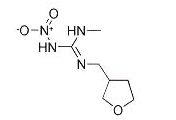b

Thank You!
Your requirement has been sent, we will contact you quickly!
Sent Failed!
Try again!
Structure:

Synonymous:“Furan nicotine "
Molecular formula: C7H14N4O3
Molecular weight: 202.2111
Density: 1.42 g / cm3
Melting point: 107.5 ℃
Boiling point: 334.5 ℃ at 760 mmHg
Steam pressure: 0mmhg at 25 ℃
Storage conditions: 0-6 ℃
Appearance: white powder
Product Feature: the agent has the characteristics of contact killing, stomach toxicity, strong absorption in the root, high quick effect, long duration of 4-8 weeks (theoretical duration of 43 days), wide insecticidal spectrum, excellent control effect on the insect pests of the mouthpiece, and shows high insecticidal activity at a very low dose. It is mainly used to control aphids, leafhoppers, planthoppers, thrips, whiteflies and their resistant strains on wheat, rice, cotton, vegetables, fruit trees, tobacco and other crops. At the same time, it is highly effective against Coleoptera, Diptera, Lepidoptera and Homoptera pests, as well as health pests such as cockroaches, termites and houseflies.
Toxicity: Furamethoxam is very safe for mammals. Its acute oral LD50 is 2450mg / kg for male rats and 2275 for female rats mg/kg; Male mice 2840mg / kg, female mice 2000mg / kg. Acute percutaneous LD50 > 2000mg / kg in rats (female and male). No teratogenicity, carcinogenicity and mutagenicity. Furamethoxam is also very safe for aquatic organisms. Fish toxicity test showed that furamethoxam had a significant effect on carp nm (48 h) > 1000mg / L for Daphnia. Similarly, furamethoxam has low toxicity to birds, and acute oral LD50 > to quails 1000mg/kg。 According to the bee experiment, the toxicity of furamethoxam to bees is medium to high risk, and it is forbidden during plant pollination and flowering.

